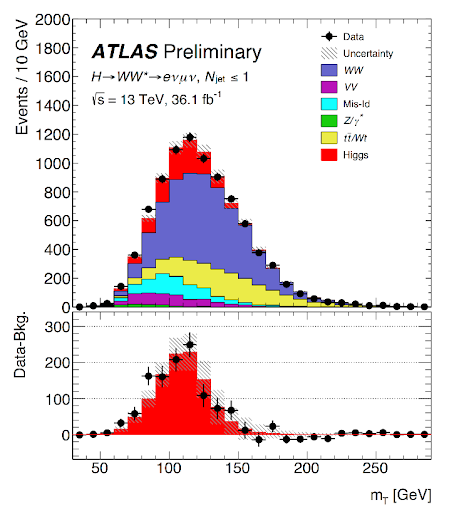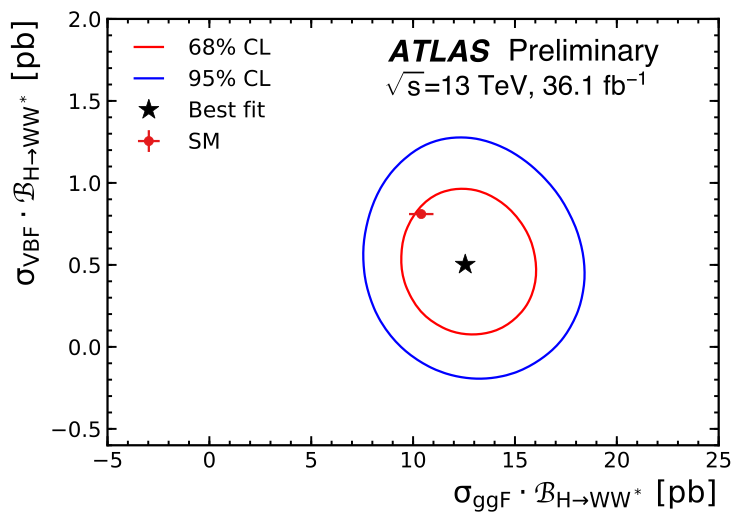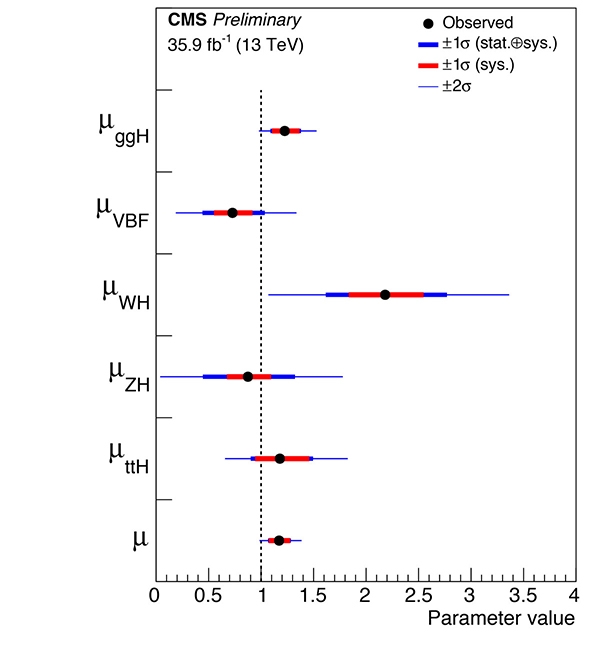LHC experiments present results in Moriond Conference
This year saw the 53rd meeting in the series "Les Rencontres de Moriond". ATLAS and CMS presented impressive results (see pictures) of searches for new phenomena, setting boundaries to where the new physics can still exist. These limits severely constrain models for physics beyond the Standard Model including possible candidates for dark matter and searches for supersymmetric particles. It should be noted that the Standard Model processes contribute to the background of many searches for new physics and measuring these processes precisely helps separate the background from a potential signal. In addition, any deviation from the Standard Model’s predictions could be the door that leads to new physics.
LHC experiments presented their updates to their measurements of boson (W and Z) and di-boson decays, including the whole 2015 and 2016 dataset of the LHC. These decays appear in typical searches for the Standard Model Higgs and new physics, and thus need to be understood with a high degree of precision. Moreover, ATLAS and CMS also presented a wide range of results that looked at the characteristics of particle jets, including new, detailed measurements of jet and di-jet cross-sections. A high precision understanding of these jets is essential, as they form the basis for most of the measurements made by the experiments.
The ATLAS collaboration examined the Higgs boson decaying into two W bosons (H → W+ W-), the charged force carriers of the weak interaction. The analysis uses 36 fb-1 of Run 2 data taken in 2015 and 2016 at a collision energy of 13 TeV. With a predicted decay probability (branching fraction) of about 21%, H → W+ W- is the most common decay mode after the decay to b-quark pairs; yet it required a tour de force to achieve this result.
The present analysis is similar to earlier analyses carried out on the 7 and 8 TeV datasets from Run 1: it focuses on the most ubiquitous Higgs boson production modes, where either two gluons (ggF), or two W or Z bosons (VBF) emitted by the colliding protons fuse to produce the Higgs boson. The W bosons from the Higgs boson decay are unstable and immediately decay to lighter particles. Decays to electrons and muons are considered, which provide a cleaner signal than the more abundant decays to a pair of quarks, but which reduce the exploitable H→W+W- branching fraction to only 1.1%. An additional challenge is that these W boson decays are accompanied by invisible neutrinos, giving rise to missing energy in the event, thus making the signal reconstruction more challenging.
Data taking conditions are quite a bit harsher in Run 2, with increased beam intensity at the collision point leading to up to 60 simultaneous proton-proton interactions per bunch crossing. This made it much more difficult to distinguish the electrons and muons from W boson decays from other sources, and even from other particles. Refining the analysis proved a challenge – one that has now been met by ATLAS.

Figure 1: The contribution from the Higgs boson is shown in red, the bottom panel compares the background-subtracted data points to the expected yield from the Higgs boson in the red histogram. (Image: ATLAS Collaboration/CERN)
Figure 1 shows the so-called transverse mass of the events, computed from the visible and invisible decay products of the Higgs boson candidates. The red contribution is the expectation from the Higgs boson, and the other colours represent various background processes. The Higgs-boson signal, which amounts to a significance exceeding six standard deviations, is clearly visible in the figure. Figure 2 shows the measured cross sections times branching fractions for Higgs boson decays to two W bosons for the ggF and VBF production modes.

Figure 2: The measured cross sections times branching fractions for Higgs boson decays to two W bosons for the gluon-gluon fusion (ggF) and vector boson fusion (VBF) production modes. The measured values are 12.3 +2.3 / -2.1 pb and 0.5 ± 0.3 pb, respectively, which are in agreement with precise theoretical calculations based on the Standard Model. The contours surrounding the measured values indicate the 68% and 95% confidence intervals, the SM expectations (the red point in the plot) are compatible with the measured values. (Image: ATLAS Collaboration/CERN)
The H → W+W- decay played an important role in the scrutiny of the Higgs boson’s nature with Run 1 data, and ATLAS expects it to carry its weight in the even more incisive tests that will be possible with the further Run 2 data.
The CMS collaboration presented more than 25 new results at the 2018 Rencontres de Moriond conference. Most of these results will be published shortly and will add to the growing total of Run 2 CMS publications. Highlights include a set of combined measurements of the production and decay rates of the Higgs boson, as well its couplings to vector bosons and fermions, a first observation of the rare decay Z → ψ l+l−, and several searches for rare Higgs decays, supersymmetry and other exotic particles. A search for heavy resonances in the di-electron final state with the large data sample collected in 2017 is also presented.
The Higgs measurements use the 2016 data sample for a comprehensive analysis of the production processes gluon fusion, vector boson fusion, and associated production with a W or Z boson or a pair of top quarks, and of the H→ZZ, WW, γγ, ττ, bb and μμ decay modes. Dedicated searches for invisible Higgs boson decays are also considered. The combined signal yield relative to the standard model prediction has been measured to be 1.17 ± 0.10. A significant improvement in the precision of the gluon fusion production rate of around ∼30% has been achieved compared to the previous ATLAS and CMS combined measurement with Run1 data. Results for the Standard Model Higgs boson decaying via the bb channel and produced in association with a top quark-antiquark pair decaying into the all-jet and leptonic final states are also presented.

Figure 3: Summary plot of the fit to the per-production mode Higgs signal strength modifiers μi. The thick and thin horizontal bars indicate the ±1σ and ±2σ uncertainties, respectively. Also shown are the ±1σ systematic components of the uncertainties. The last point is taken from a separate fit and indicates the result of the combined overall signal strength μ.The first observation of the Z boson decay to a vector meson and two oppositely charged same-flavour leptons is presented, with a statistical significance of 5.7σ. Using 35.9 fb-1 of data 13.0 ± 3.9 events of the decay Z → ψ μ+μ− and 11.2 ± 3.4 events of the decay Z → ψe+e− have been observed. A measurement of jet substructure observables in top quark events and a study of the properties of the underlying event in top quark events is also presented.
CMS has also released more than 15 direct searches for new physics using the full 2016 dataset. These exotic searches provide new stringent limits on exotic decays of the Higgs boson, dark matter scenarios, hypothetical particles such as leptoquarks, new heavy gauge bosons, long-lived particles and several supersymmetry scenarios. Finally, CMS also presents a search for high mass resonances in the di-electron final state using the 41 fb-1 of data collected during 2017. This is the first result from the analysis of the 2017 dataset and in combination with the analysis of the 2016 data sets stringent limits on the masses of Z’ particles that arise in many new physics scenarios. This CMS result is indicative of the high quality of the data collected in 2017 and more results using this dataset are expected to come out later this year.
LHCb presented a wealth of interesting results including the first evidence for the Bs0→ K*0μ+μ- decay with a statistical significance of 3.4 standard deviations. This decay is predicted to be very rare within the SM, as it occurs only through suppressed loop diagrams. New particles foreseen in extensions of the SM can significantly enhance (or suppress) the rate of this decay. The result presented at the Rencontres de Moriond paves the way to search for new physics using this decay when a larger datasets will be collected by the upgraded LHCb detector during LHC Run 3.
Results of a search for new dimuon resonances were also shown in Moriond. No evidence is found for a signal in the mass range of 5.5 to 15 GeV and upper limits are placed on the product of the production cross-section and the branching fraction to pairs of muons. The limits are competitive with the most stringent ones over most of the mass region considered, and are the first limits set near the Υ resonances.

Figure 4: The image shows the mass spectrum of the muon pair in the whole search region. Mass peaks for five hypothetical Φ-boson mass hypotheses are displayed in green.
The LHCb collaboration also presented a number of measurements about CP violation in B decays. Seeing a departure from the value predicted by the Standard Model for rare B decays branching ratios would be a sign of CP violation and could open the door to new physics. First of all, decay-time-dependent CP asymmetries in B0→D∓π± decays are measured for the first time in a hadron collider. The image shows an example of the measured asymmetry as a function of the decay time of the B0.
The parameters describing the difference in behaviour between matter and antimatter, known as CP violation, are constrained in the so called Cabibbo-Kobayashi-Maskawa matrix unitarity triangle. The angles of this triangle are denoted α, β and γ, and among them, γ is the least precisely known. The measurement of the asymmetries presented for the first time allow to constrain the angle γ to an interval that is consistent with the current world average. The blue line in the image is the result of this analysis, while the red, dashed line shows the expectation in the absence of CP violation.
Moreover, CP violation in decays of B0 and of Bs0 mesons into two charged particles (h) also allow for precise tests of the CKM triangle angle. Results from time-dependent CP asymmetries in B0→π+π- and Bs0→K+K- decays as well as of the time-integrated CP asymmetries in B0→K+π- and Bs0→π+K- decays were presented contributing to the determination of the CKM unitarity triangle. Finally, measurements of the time dependent CP-violating asymmetry in the Bs0 decay to two φ mesons was presented and are consistent with the hypothesis of CP conservation.
Following the results presented at the electroweak session of Rencontres de Moriond, the LHC experiments also presented many new results for the following week’s quantum chromodynamics (QCD) session. Les Rencontres de Moriond have now ended but the LHC experiments continue working on many fronts. They prepare for recording and analysing new data to probe more precisely as many characteristics of the Higgs boson as possible and push further the experiments’ diverse physics programme including new searches.
All presentations from ATLAS and CMS and LHCb, as well as results from ALICE, can be found on the Moriond conference websites: Electroweak physics and QCD physics.
